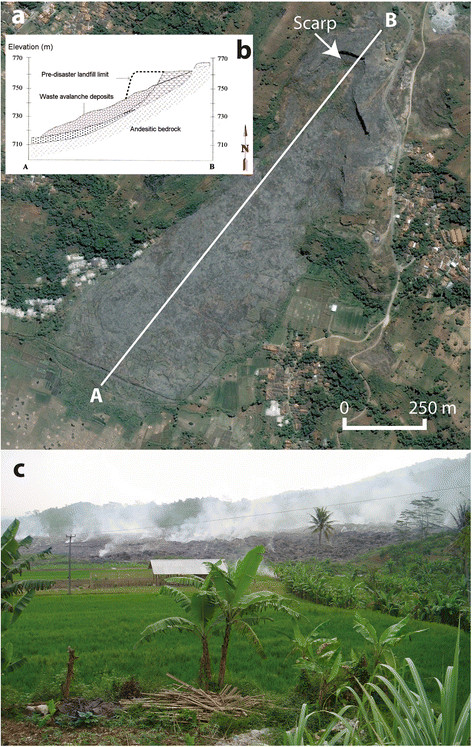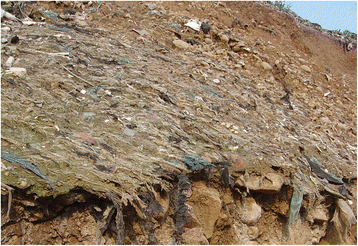16 April 2015
Review of a paper:- The 2005 waste landslide at the Leuwigajah dumpsite in Indonesia
Posted by Dave Petley
The 2005 Leuwigajah dumpsite landslide
For many people the thought of being buried alive is a true horror, and for good reason. However, the thought of being buried alive in a surge of garbage – filthy, rotting, stinking and even on fire – takes the terror to a new level. For those unfortunate people that make their living picking rubbish from garbage sites this is a very real fear. It is impossible to know how many people die this way – many in all probability, but few fatalities are ever recorded. Occasionally though a catastrophic slide occurs on a waste site, with multiple deaths. The worst known case occurred at the Payatas waste site near Manila in the Philippines in 2000, killing 278 people. The second worst example occurred more recently at 2 am on 21st February 2005 at the Leuwigajah dumpsite, near to Bandung city in Java, Indonesia. The landslide killed 143 people, having buried 71 houses. In a paper published recently, available via open access (hurrah!), Lavigne et al. (2014) have undertaken a detailed investigation of this landslide. I think that this is a really important piece of work that deserves attention.
The paper includes images of the landslide, both from aerial photography and on the ground. The extraordinary nature of the Leuwigajah dumpsite landslide is clear:

“Deposits of the 21 February 2005 waste avalanche at Leuwigajah. (a) Aerial view on 3 August 2006 (source: GoogleEarth). (b) Longitudinal profile. Dotted area: regolith and soil; (c) Picture of solid waste deposits overlapping rice fields. Notice the smoke emissions attesting permanent deep combustion (photo: F. Lavigne, 22 July 2005). From Lavigne et al. (2014)
.
The landslide volume was 2.7 million cubic metres of waste, traveling over a distance of about 1000 m and leaving a deposit that was on average 10 m thick. The team investigated the movement of the landslide, and explored its internal structure. They found that the landslide moved as a flow, and that the rate of movement was rapid. Examination of the distance that the landslide moved compared with its height change suggest that the Leuwigajah dumpsite landslide showed unusually high mobility (i.e. the apparent friction was lower than would be expected), a really interesting observation. The authors suggest that this may have been because the waste contained very large numbers of plastic bags, which facilitated internal deformation of (i.e shear within) the landslide mass. This extraordinary image, included in the paper, shows the essentially uniform horizontal orientations of the plastic bags in the landslide mass after the slide:

“Pieces of plastic bags displaying horizontal orientations along the post-disaster scarp of the dump (Photo: F. Lavigne, July 2005).” From Lavigne et al. (2014)
The details of the fate of the victims are pretty horrifying To quote the paper:
“In the months preceding the 2005 disaster, fires have been reported at the Leuwigajah dump site. Eyewitnesses reported that the waste mass was on fire while moving. Fires may have spread quickly because the landfill contained highly flammable combustible material. All the bodies of the victims were burnt, and the studied material was rather deeply charred.”
So why did the Leuwigajah dumpsite landslide occur? The authors suggest that the normal combination of processes were present – i.e. weak material forming a slope that was too steep; etc. But in this case, the release of methane, possibly explosively, from the waste may have rapidly reduced the shear strength of the waste, initiating movement. Secondly, prior to the landslide event the area suffered three days of heavy rainfall (exceeding 80 mm per day), which drive up pore water pressures. And finally, the authors suggest that the ongoing fires within the debris may have progressively weakened the waster materials, creating the conditions for the landslide.
Of course, these types of landslides are avoidable with proper management of the dumpsite. And, as Lavigne et al, (2014) make clear, the easily forgotten factor is the extreme vulnerability of the populations at risk. Sadly there remain many people making a living on these highly dangerous sites. It is now a decade since the Leuwigajah dumpsite landslide. It can only be a matter of time before a repeat of the Leuwigajah dumpsite landslide occurs.
Reference
Lavigne, F., Wassmer, P., Gomez, C., Davies, T., Sri Hadmoko, D., Iskandarsyah, T., Gaillard, J., Fort, M., Texier, P., Boun Heng, M., and Pratomo, I. (2014). “The 21 February 2005, catastrophic waste avalanche at Leuwigajah dumpsite, Bandung, Indonesia.” Geoenvironmental Disasters, 1, 10. doi:10.1186/s40677-014-0010-5


 Dave Petley is the Vice-Chancellor of the University of Hull in the United Kingdom. His blog provides commentary and analysis of landslide events occurring worldwide, including the landslides themselves, latest research, and conferences and meetings.
Dave Petley is the Vice-Chancellor of the University of Hull in the United Kingdom. His blog provides commentary and analysis of landslide events occurring worldwide, including the landslides themselves, latest research, and conferences and meetings.